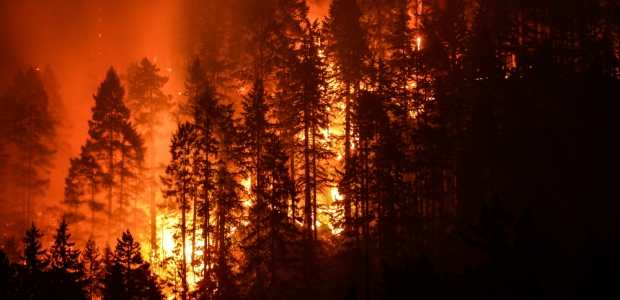
Scientists Analyzing Smoke of Western Wildfires
The project brings together scientists from five universities and the NSF-funded National Center for Atmospheric Research. "This is a challenging field campaign," said atmospheric scientist Emily Fischer of Colorado State University. "It's not like measuring the plume from, say, a power plant."
A comprehensive effort to analyze smoke from western U.S. wildfires is getting under way. The Western Wildfire Experiment for Cloud Chemistry, Aerosol Absorption and Nitrogen, or WE-CAN, is supported by the National Science Foundation (NSF) and will be the largest attempt to date. From late July through August, a four-engine cargo plane based in Boise, Idaho, and carrying scientists and sophisticated equipment will make 15-20 flights straight into hazy smoke from those wildfires.
The project is partly supported by NOAA and NASA.
"These researchers are following the transport and transformation of the plume of gases and aerosols emitted by wildfires to understand the chemical changes they undergo over time, how their properties might vary, and their impacts on human health and the environment," said Sylvia Edgerton, a program director in NSF's Division of Atmospheric and Geospace Sciences, which funds WE-CAN.
The project brings together scientists from five universities and the NSF-funded National Center for Atmospheric Research. "This is a challenging field campaign," said atmospheric scientist Emily Fischer of Colorado State University. "It's not like measuring the plume from, say, a power plant. We don't know exactly where the fires will be, but we know that pretty much every year, there is a wildfire burning within a two-hour flight of Boise during the month of August."
The researchers will attempt to answer questions such as these: What is the smoke made of? How does it change over time and as it travels? How does it affect clouds? How does the type and growth of the forest affect the composition of smoke produced? How does the smoke chemistry of hot-burning fires compare to that of lower-temperature, smoldering fires? The answers are important for studies of air quality, weather, and climate.
According to NSF's announcement, the diverse backgrounds of the team reflect the scope of the scientific questions they will explore. Fischer's expertise is in reactive nitrogen and ozone; her group will take the lead on measurement of atmospheric ammonia. Shane Murphy of the University of Wyoming will head the investigation into absorbing aerosols. Other scientists from CSU, including Paul DeMott and Amy Sullivan, will explore smoke particles and their effects on clouds.
WE-CAN goes above and beyond other wildfire air-quality experiments conducted in the past, said Fischer. She explained that previous atmospheric science field campaigns have touched on wildfire smoke, but that has not been their main focus. "What we are doing in WE-CAN is much more systematic," she said. "We will start as close as we can to the fires and track the smoke for 12 to 24 hours. That's when a lot of the chemical evolution happens. We have very few existing samples of this evolution in the atmosphere."
On Aug. 11, the WE-CAN team will host a research aircraft media event at the Boise Airport.